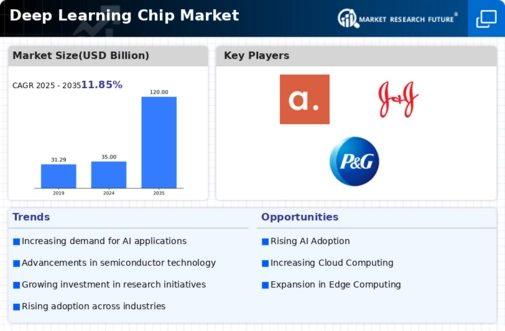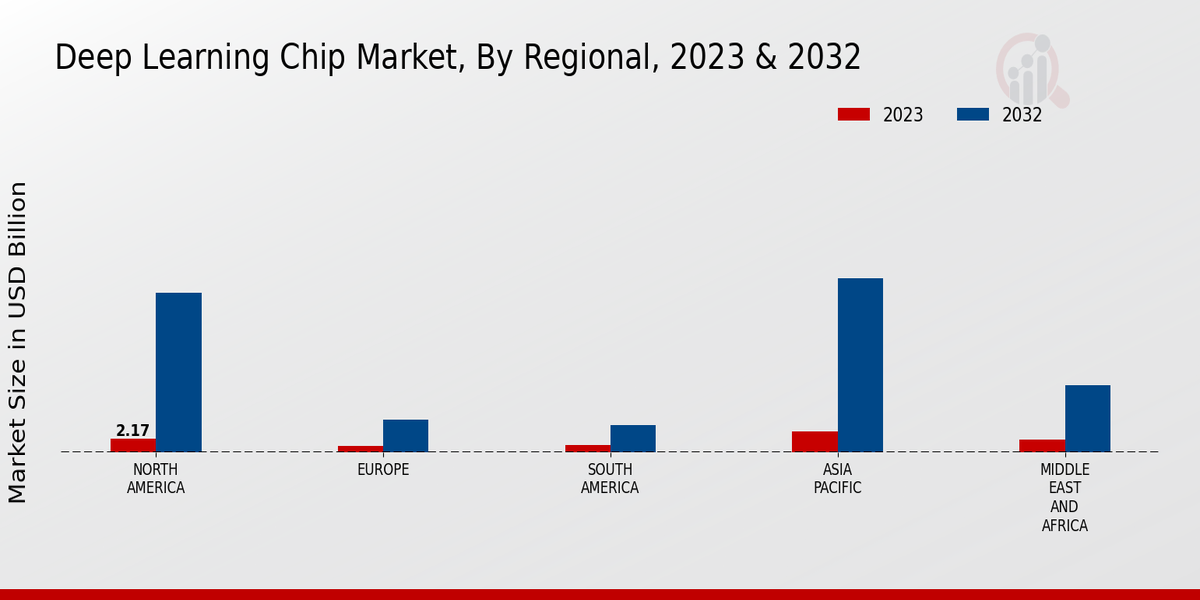Market Growth Projections
The Global Deep Learning Chip Market Industry is poised for substantial growth, with projections indicating a market value of 35 USD Billion in 2024 and an anticipated increase to 120 USD Billion by 2035. This growth trajectory reflects the increasing integration of deep learning technologies across various sectors, driven by advancements in semiconductor technology and rising demand for AI applications. The compound annual growth rate of 11.85% from 2025 to 2035 underscores the industry's potential for expansion, as organizations continue to invest in deep learning capabilities to enhance their competitive edge.
Rising Demand for AI Applications
The Global Deep Learning Chip Market Industry experiences a surge in demand driven by the increasing adoption of artificial intelligence applications across various sectors. Industries such as healthcare, automotive, and finance are integrating AI to enhance operational efficiency and decision-making processes. For instance, AI-powered diagnostic tools in healthcare are revolutionizing patient care, while autonomous vehicles rely heavily on deep learning for navigation and safety. This growing reliance on AI technologies is projected to propel the market value to 35 USD Billion in 2024, indicating a robust trajectory as organizations seek to leverage deep learning capabilities.
Growing Adoption of Edge Computing
The shift towards edge computing is reshaping the Global Deep Learning Chip Market Industry, as organizations seek to process data closer to the source. This trend is particularly relevant for applications requiring real-time data analysis, such as smart cities and IoT devices. By deploying deep learning chips at the edge, companies can reduce latency and bandwidth usage while enhancing data security. The integration of deep learning capabilities into edge devices is expected to drive market expansion, as businesses recognize the benefits of localized processing. This growing adoption is indicative of a broader transformation within the technology landscape.
Advancements in Semiconductor Technology
Technological advancements in semiconductor manufacturing are significantly influencing the Global Deep Learning Chip Market Industry. Innovations such as smaller process nodes and improved architectures enable the production of more efficient and powerful chips. For example, the introduction of 7nm and 5nm process technologies allows for higher transistor density, leading to enhanced performance and reduced power consumption. These advancements not only cater to the increasing computational demands of deep learning algorithms but also contribute to cost reductions. As a result, the market is expected to witness substantial growth, with projections indicating a rise to 120 USD Billion by 2035.
Emergence of Cloud-Based Deep Learning Solutions
The rise of cloud-based deep learning solutions is significantly impacting the Global Deep Learning Chip Market Industry. Cloud platforms provide scalable resources for training and deploying deep learning models, making advanced AI capabilities accessible to a wider range of businesses. Organizations can leverage these platforms to avoid the high costs associated with on-premises infrastructure while benefiting from the latest advancements in chip technology. This trend is likely to accelerate market growth, as more companies transition to cloud environments for their deep learning needs, thereby enhancing their operational efficiency and innovation potential.
Increased Investment in Research and Development
Investment in research and development within the Global Deep Learning Chip Market Industry is on the rise, as companies strive to innovate and maintain competitive advantages. Major technology firms are allocating significant resources to develop next-generation chips that can handle complex deep learning tasks more efficiently. For instance, companies are exploring neuromorphic computing and quantum computing as potential avenues for enhancing deep learning capabilities. This focus on R&D is likely to drive market growth, with a compound annual growth rate of 11.85% anticipated from 2025 to 2035, reflecting the industry's commitment to advancing deep learning technologies.














Leave a Comment